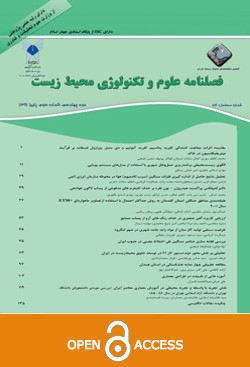ارزیابی تاثیرات هوشمندسازی شهر با تاکید بر مولفه های توسعه پایدار
محورهای موضوعی : معماری و شهرسازیmalihe ahmadi 1 , مرتضی عمرانی 2
1 - Department of urban planning, College of technical and engineering
Shahre-e-Qods Branch, Islamic Azad University, tehran,, Iran
2 - كارشناس ارشد معماري، دفتر نظارت بر طرحهاي توسعه و عمران، وزارت راه وشهرسازی.
کلید واژه: هوشمندی, پايداری شه, شبکه های الکترونیکی, مشارکت شهروندی, منطقه بندي,
چکیده مقاله :
زمینه و هدف رشد فزاینده جمعیت جهان و گرایش عمده به سوی شهر نشینی، آثار فاجعه آمیزی بر محیط و فضاهای شهری داشته است.این پژوهش با هدف صرفه جویی در منابع، زمان و انرژی در شهرها، به تبیین مفهوم "هوشمندی" در شهروشناسایی و معرفی روشهای موثربرارتقا کیفیت زندگی شهری پرداخته است. روش بررسی: با توجه به موضوع مورد مطالعه، با رویکردی "تحلیلی- توصیفی"به شناخت "ویژگیهای شهر هوشمند" بعنوان شاخص ها پرداخته شده و با محاسبه امتیاز هر یک از شاخص ها و بررسی و ارزیابی آنها ،موثرترین نتایج حاصل از هوشمندسازی شهرها تعیین می شوند. یافته ها: این تحقیق نشان میدهد نیاز و هزینه اصلی شهرهای هوشمند، ایجاد زیرساخت های شهری گسترده ای است که نه تنها از منظر اقتصادی سودآوری و بهینه سازی را به همراه دارند، بلکه کیفیت زندگی شهروندان را به طور مطلوب ارتقاء می دهند. بحث و نتیجهگیری: از بررسی جدول نهایی که نتایج تحقیق در آن منعکس شده است مشاهده می شود که " ایجاد صرفه اقتصادی کلان" دارای بیشترین کمیت عددی بوده و در نتیجه از تاثیر حداکثری برای هوشمند سازی برخوردار است. عامل مهم دیگرامکان" دسترسی" به اطلاعات دقیق در زمینه ایجاد شهرهای هوشمند می باشد.
Introduction: Growing world population and major trends towards urbanization, will have catastrophic effects on the environment and urban spaces. This study aimed to save resources, time and energy in cities, is about the concept of "intelligence" in the city and identify effective methods of improving the quality of urban life.
Material and method: According to the study, with approach "descriptive-analytical", to identify "features smart city" as indicators discussed, by calculating a score for each indicator, and evaluate them, the most effective results of intelligent cities are determining.
Results: This study reveals the need and cost of smart cities, is creating the city-wide infrastructure, not only from an economic perspective as well as optimizing their profitability, but also it is desirable to promote the quality of citizens life.
Conclusion: The results of the review of the final table, which is reflected in its, show the "Creating the macro economy" has been the largest numeric quantities and as a result, the effect is maximal for smart cities. Other important factor is the possiblity of " accessibility" for detailed information about creating smart cities.
1. http://vista.ir/content/11789
2. قیسوندی، حمید، آرمان قیسوندی و کیهان قیسوندی، 1390، «شهر هوشمند، تکوین انقلاب شهری نوین»، "شهراکترونیک واقعیت شهرهای فردا"، نخستین همایش ملی آرمان شهر ایران، نور، دانشگاه آزاد اسلامی واحد نور
3. کیانی، اکبر، 1390،"شهر هوشمند ضرورت هزاره سوم در تعاملات یکپارچه شهرداری الکترونیک(ارائه مدل مفهومی، اجرایی با تاکید بر شهرهای ایران)"، فصلنامه جغرافیایی آمایش محیط، شماره 14
4. Breheny, M. (1995) "Conterurbanisation and sustainable urban forms, in Cities in Compatition” (eds J. Brotchie, M. Batty, E. Blakely, P. Hall and P. Newton), Longman Australia, Melbourne.
5. UN DESA continent population 1950 to 2100.svg
6. Banister, D, Watson, S. andWood, C. (1997)” Sustainable cities, Transport, Energy, and Urban Form, Environment and planning” B,24(1)
7. http://www.imagesgoogle.com/smartcity
8. Brotchi, J, Gipps, P.and Newton, P. (1995) ” Urban landuse, transport and the information economy : metropolitan imployment, journe to work trends and their implications for transport”, Urban Futures,17.
9. Castells, M. (1989) ”The Informational city : Information Technology, Economic Restructuring and the Uban Regional Process”, Blackwell, Oxford.
10. Troy, P. (1996) ” Urban consolidation and the family, in The Compact City : A Sustainable Urban Form ” (eds M. Jenks, E. Burton and K. Williams), E & FN Spon, London.
11. Gordon, P, Kumar, A.and Richardson, H.W. (1989) ”The influence of metropolitan spatial structure on commuting times”. Journal of Urban Economics,26.
12. Marcus, Jason, 1997,” The Invironmental and Social Impacts Of Telecommuting and Teleactivities” : Chpt :7, at : http://www.oldgrowth.org/Telecommute/7reduction-auto.html.
13. Dittmar, H.and Cook, K,1997, ” Mean Streets Pedestran Report”, at : http://www.transact .org/mean/for/html.
14. Quay, Ray,1993, Telecommuniting : ”Possible Futuers For Urban & Rural Communities”, Planning Commisionals Journal Vol :12 :16
15. Graham, Stephan,1995. ”Cyberspace and the City”, T & CP journal :198.
16. Bursuk, Mark,1996. ”What Is The Impafct Of Infotech On Commerchial Real Estate”, Presented To : Real Estate Roundtable Stanford Business School Alumni Association, at : http//www.telecommute.org/brusk3.html

